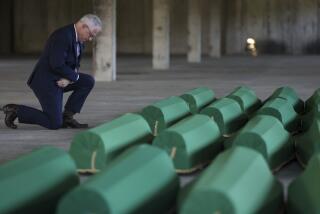Group’s Alleged Role in Slaying Raises Questions
- Share via
BELGRADE, Serbia and Montenegro — They lined up men, women and children to be shot or knifed or bludgeoned. Their reputation was so fearsome that whole villages emptied when people heard that they were around. War crimes prosecutors say the group’s orders -- and protection -- came from the very top during the bloody years of Slobodan Milosevic’s rule.
Now the Red Berets, a notorious paramilitary organization that dates to the Yugoslav wars of the 1990s, are suspected of participating in the daring sharpshooter attack that killed Serbia’s top government official, Prime Minister Zoran Djindjic. On Thursday, the government announced the arrest of several suspected Red Beret members.
Their alleged involvement in Djindjic’s assassination brought into question whether the Serbian leader was killed purely to forestall a crackdown on an organized crime ring called the Zemun clan, as some in the government have said.
Some observers believe that former Red Beret members, many of whom are now part of the Zemun clan, may have participated in the attack not to prevent a gang clampdown but rather to avoid being turned over to the war crimes tribunal at The Hague.
Djindjic’s government had come under heavy pressure from the West to cooperate with the international war crimes tribunal, and some former Red Berets -- particularly the group’s leader, Milorad Lukovic, better known as Legija -- are rumored to be close to the top of the Hague tribunal’s list of wanted fugitives.
Legija’s men, who are fiercely loyal to him, were reputedly the most violent of the special operations units whose job was, in effect, to help create a “Greater Serbia.”
The group was formed sometime in the early ‘90s, allegedly under orders from Milosevic, as a secret weapon in the Serbian cause. Put together by, paradoxically, an ethnic Croat named Franko Simatovic, who was detained by authorities this week, the original gang was a somewhat ragtag band of former policemen and convicts. Some people say they were promised a pardon if they signed up for the cause.
They were known in the beginning as “Frenki’s boys” and established themselves early: In 1991, according to a published interview with an unidentified former member, the men killed about 100 Muslims and Croats in the city of Mostar, in Bosnia-Herzegovina.
The former Red Beret described how five of his fellow fighters lined up their civilian victims along a riverbank, then shot, stabbed or beat them to death in half an hour.
The group had its own anthem, which began, “I swear on my honor and life that I will loyally defend Serbian people where they are.” Its symbol was a wolf’s head, with fangs bared.
At some point, Simatovic was succeeded at the helm by Lukovic, a former member of the French Foreign Legion. He was known as Legija, for “legionnaire,” in accordance with the group’s tradition of assigning nicknames to its members. As a rule, just the sobriquets were used: Godfather, Rat, Fool. Only Legija knew the men’s identities.
For all the group’s reputation and the violence it allegedly visited on non-Serbs, its leader managed to preserve a remarkable degree of anonymity. Until recently, Legija never appeared in any photographs, and it was some time before people figured out his real name -- a task made more difficult because he reportedly changed his surname from Ulemek to the common Lukovic, his wife’s last name.
Human rights advocates draw a direct line from the Red Berets to Milosevic, who now sits in the dock at The Hague. Besides killing Bosnian Muslims, Croats and Kosovo’s ethnic Albanians, the group is also believed to have committed at least two political assassination and kidnapping attempts under Milosevic’s rule. The first targeted opposition politician Vuk Draskovic, who survived the attempt on his life in 1999, and the second, in 2000, was aimed at a mentor-turned-critic of Milosevic, former Serbian President Ivan Stambolic. Stambolic disappeared on his morning jog and has never been found.
The Red Berets, however, were partially responsible for Milosevic’s downfall.
When anti-Milosevic protesters thronged the parliament in the fall of 2000, the Red Berets sat on the sidelines. They had been persuaded not to intervene by a member of Milosevic’s political opposition.
That man was Zoran Djindjic.
More to Read
Sign up for Essential California
The most important California stories and recommendations in your inbox every morning.
You may occasionally receive promotional content from the Los Angeles Times.














